The Boss SD-1 “Super Overdrive” is an iconic overdrive pedal that’s been a staple on guitarists pedal boards since its original release in the 1980s.
I’ve had this pedal for over 10 years – it’s actually one of the first pedals I bought! During this time, I’ve put it through its paces. Practicing, recording, live performing… it’s been through it all.
As someone who owns and frequently uses my Boss SD-1, I’ve written this review to share everything I’ve learned about it over the years to help you to decide whether it’s worth your money.
In this review, I’ve covered its key features, price, build quality, and (most importantly!) how it sounds.
Affiliate disclaimer: This page contains affiliate links for products that I’ve tried and tested. As an Amazon Associate I earn from qualifying purchases at no additional cost to you. Learn more here.
Review summary of the Boss SD-1
The Boss SD-1 is an affordable, high-quality overdrive pedal that combines a sturdy build with an incredible sound.
Its beginner friendly controls allow instant access to dialling in a wide range of tones, from a clean boost to a heavily-saturated tone, rich with harmonics. It’s great for classic rock tones and vintage metal (think early Black Sabbath).
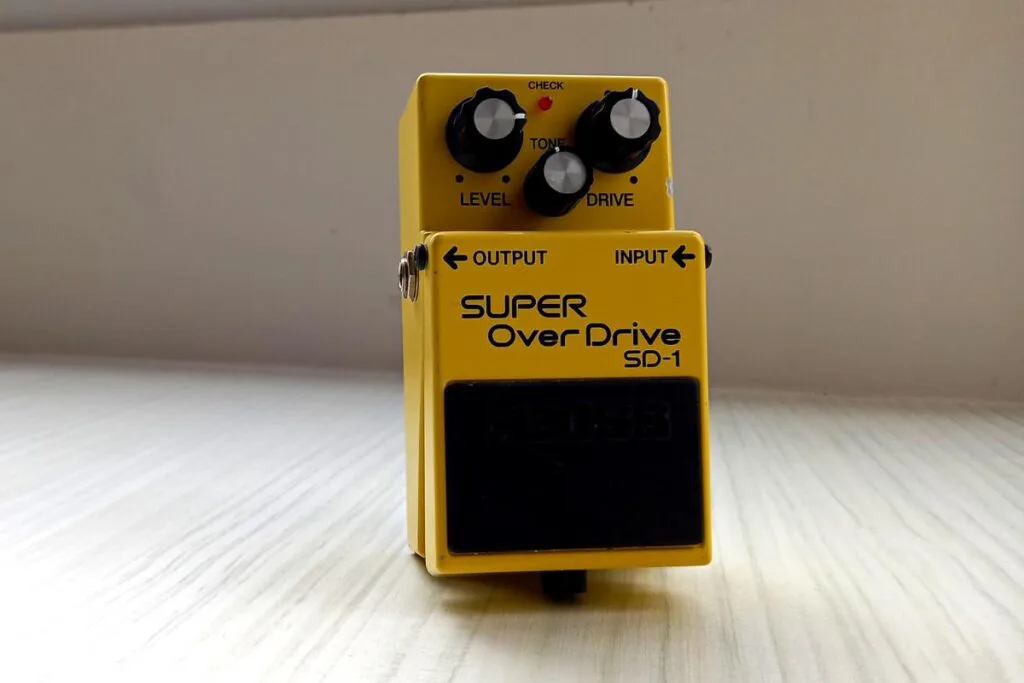
I’d recommend Boss SD-1 to any beginner looking for a great sounding and affordable pedal that will last them well into their later guitar-playing years.
You can check out out the latest price here on Amazon.
Features
The Boss SD-1 follows the same familiar design used by Boss’ other “stompbox” pedals.
It’s made from a solid metal frame (painted canary yellow) with the control knobs sitting together at the top of the pedal with two jacks: input on the right and output on the left.
Like other Boss pedals, you just stomp on it to engage it, and stomp again to turn it off. It’s not a “clicky” pedal, so you don’t have to stamp hard – it only takes a firm press.
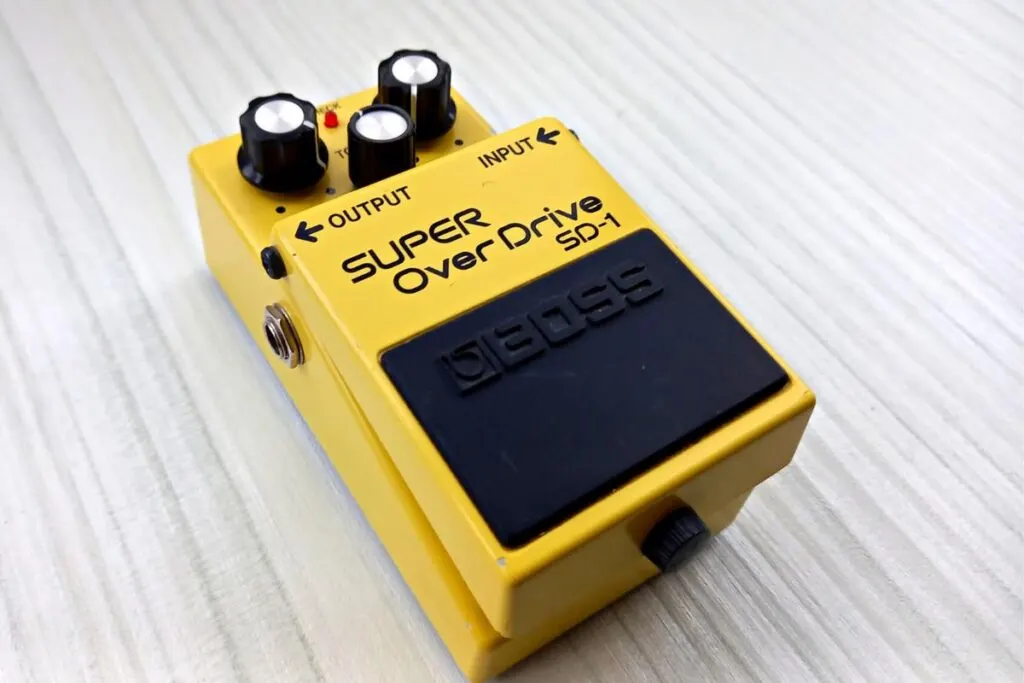
Here’s a full list of the features of the Boss SD-1:
- Asymmetrical clipping circuit
- Sturdy metal body
- Three control knobs (level, tone, and drive)
- ¼ inch jacks for input and output
- Cavity for a 9v battery
- Power adaptor (Boss 9v PSA adaptor not included)
The Boss SD-1 is simplistic in its design. There’s no hidden secrets or surprises. What you see is what you get.
While a lack of features might seem like a bad thing, it’s not. In fact, I think it’s one of its strengths.
The simple design makes the pedal accessible to newbie guitarists, who can just plug in and play. It has everything you need to get a great tone, without being too complex.
I can’t help but compare it to my other overdrive pedal, the Pork Loin by Way Huge, which has several hidden controls on the inside of the pedal. While the Pork Loin is a great pedal, I have to mess around with it to make full use of it. With the SD-1, I can just plug it in and get a great sound.
Also, I find that the simpler a pedal is, the fewer things there are to break!
The Boss SD-1 can be powered from a 9v battery (there’s space under the stompy-bit) or from a 9v Boss PSA power adapter. I’ve found that the battery lasts for several months before it needs replacing. But, the power drains if you leave your guitar leads in the input or output jacks so remember to take them out after playing.
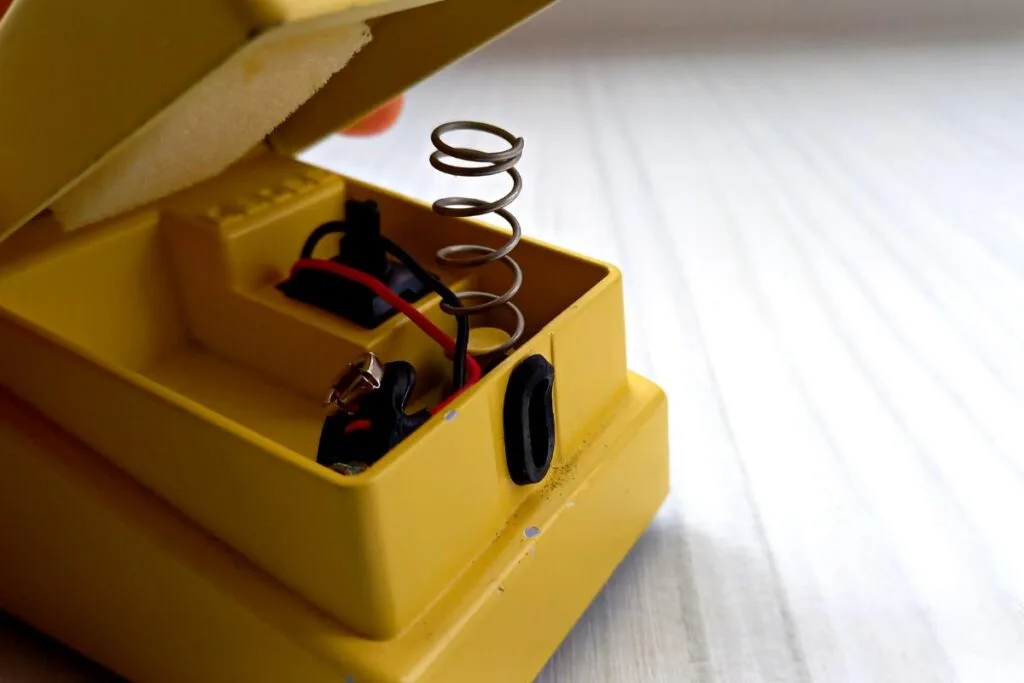
Build quality
The best way that I can describe this pedal is heavy duty. It has a solid metal body that can take a beating without slowing down.
After 10 years of owning this pedal, it has a few bits of wear-and-tear on the paint, but the important parts all work as they should.
The jacks are sturdy and there’s no “wiggle” from them, the same with the controls on the top. The knobs are made of plastic, though, so they’re more likely to break, but I’ve never had a problem with them to date.
I can’t fault the build quality at all. It’s a solid little unit.
Controls
The Boss SD-1 comes with three controls: level, tone, and drive. I’ve found that this is all I need to get a wide range of tones from it.
From a user perspective, there’s a sense of immediacy to the SD-1. As soon as I plug it in, all the controls are readily available to me. It only takes a few small tweaks to dial in the sound that I want.
The controls for the level and drive are synth-style knobs, and they’re chunky. This is great for making quick and accurate adjustments. I find them a lot easier to use than the skinny style knob used for the tone setting.
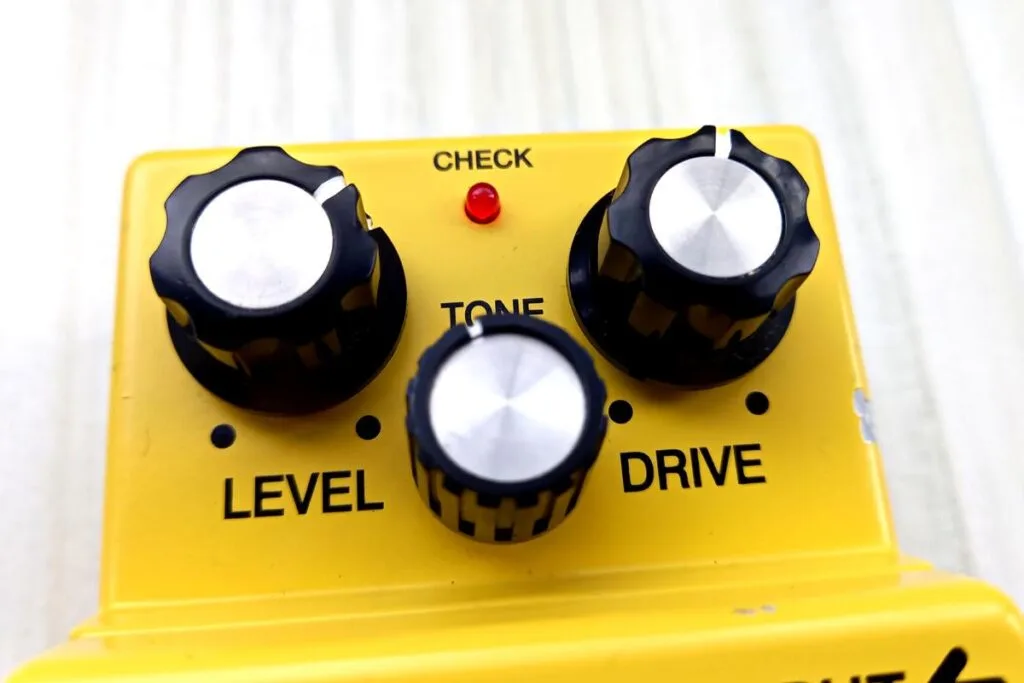
Level
The level knob sets the loudness of the output of the pedal. You can use this to match the input signal (called “gain staging”) or set it higher than the input signal to give your guitar a volume boost.
Tone
The tone knob affects the treble frequencies of the output signal. Turning the tone knob down rolls off the high-end frequencies, leaving a dark and muffled sound. When it’s turned up, the tone knob boosts the high-end frequencies, giving more brightness to the sound.
It’s a handy tool to reign in the pedal from sounding too bright, which it can if you’re using it with a Stratocaster or a bright amp like a Vox or Fender.
I also use it to add darkness and grit to my tone, which easily gets me into 1970s metal territory.
Drive
The drive knob sets the intensity of the overdrive effect. At a low setting, the pedal will have a lower amount of clipping. A higher setting means more clipping. That means more saturation, more harmonics, and more sustain!
Turning up the drive on the SD-1 gets me into near-distortion levels of clipping, but the asymmetrical clipping circuit stops it from sounding too harsh.
Price
The Boss SD-1 is one of the most affordable overdrive pedals on the market. Most other overdrive pedals in its price range are either from budget companies, or “mini” pedals from other named brands.
At this price point, I really can’t fault it. It packs a big punch for such a small price. It strikes a great balance between quality, features, and affordability. You can check its latest price here on Amazon.
Its closest comparison is the Ibanez Tube Screamer, which is incredibly similar in design (inside and out), and costs about twice as much.
For this reason, I think the Boss SD-1 is a great pedal for beginners. It’s a high-quality entry level guitar pedal that can stick with you well into your later guitar-playing years.
How it sounds
The Boss SD-1 is an overdrive pedal, which means that it’s designed to mimic the warm “soft-clipping” sound of older tube amplifiers. And it does.
The asymmetrical clipping circuit adds a rich, saturated tone that’s great for getting close to a tube sound without the cost of a tube amp. I used to own a tube amp (a Vox AC15C2) and I think this pedal really captures the overdriven tube sound, regardless of what it’s plugged into.
But it’s not just all about tube tones. This pedal can go from a subtle boost to full-on saturated (dare I say: “fuzz-like”) crunch.
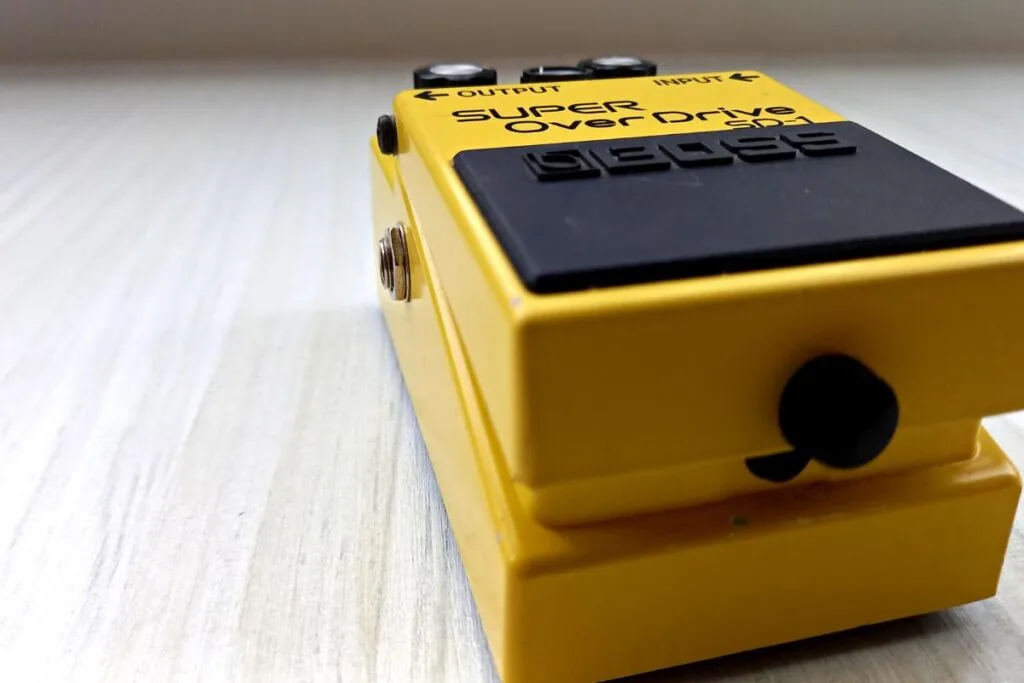
I find that it also helps add a little something-something to other pedals too. I usually pair my SD-1 with a distortion pedal to give the distortion some extra body and grit.
It also works well with other instruments too. I use this pedal on my synthesizers to give them some analog-style warmth.
All that being said, if you’re looking for a stompbox that will give you a high-gain tone for hard rock or metal, this might not be the pedal for you. Instead, I’d suggest checking out a distortion pedal. I’ve actually written a review of the Boss DS-1 here.
But, this pedal is handy for taming high-gain amps, by tightening up some of the high-end frequencies. So, even though it might not give you the high-gain tone, it can help you to control it!
Sound clips
Here’s a few sound clips I’ve made to show the range of the Boss SD-1.
Note: Each sound clip starts with the pedal turned on. Afterwards, I repeat the phrase with the pedal turned off, so you can hear the amplifier’s clean signal.
Firstly, here’s an example of a “boost” like setting. It gives the guitar some volume and high-end edge which would help it cut through in a recording or live band. It’s also great for vintage rock tones, think The Who, Pink Floyd and Cream.
Next, I dialled up the settings to create a rock tone. I didn’t change the amp settings from the previous recording, this is all the pedal! You can hear how much the SD-1 adds by listening to the clean signal at the end.
To me, this screams blues-rock, namely Joe Bonamassa and Stevie Ray Vaughan.
Finally, here’s the drive knob turned up to ten, because that’s what everybody wants to hear. I dialled down the tone knob to create an early Black Sabbath sound, that I think is pretty convincing! Again, the amp settings remain unchanged.
A common theme across all these sounds is character. The Boss SD-1 is very versatile. Adjusting the tone knob can add a little bit of “yester-year” color to your guitar tone by giving it some classic rock bite, or subtle tube warmth. Cranking up the drive can take you from a gentle boost to all out saturation.
If you want to hear even more sounds, the Boss website has a fully interactive demo of the SD-1 I recommend checking out.
Final thoughts
The Boss SD-1 is one of the first guitar pedals I bought, and I’m glad I did. It’s head and shoulders above other similarly priced overdrive pedals, and even stands up to some of my other, more expensive, pedals.
It’s perfectly priced for beginners, but has the sound of a much more advanced pedal.
I’ve not said much negative about this pedal in this review, but there really isn’t much to say. Sure, there are more advanced overdrive pedals out there, but considering the Boss SD-1’s price, and quality, I believe that it provides outstanding value for money.
I’m happy to recommend the Boss SD-1 to anyone who’s looking for an affordable, reliable, and incredible sounding overdrive pedal that will serve you well for years to come. If you think this pedal is for you, then you can shop it here on Amazon.
Related questions

Conor is a music producer, multi-instrumentalist, and all-round enthusiast from the UK with over 15 years of experience. He’s the founder and sole-content creator for the roundtable audio blog and YouTube channel.
